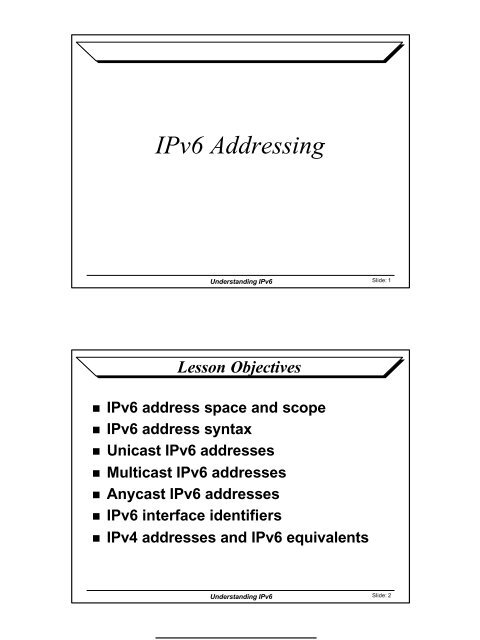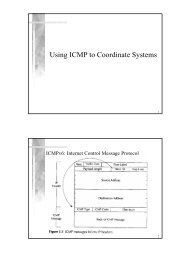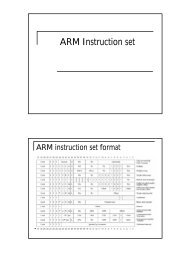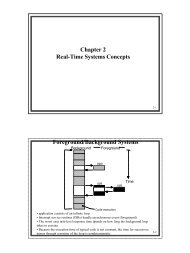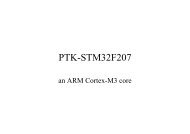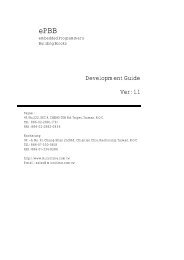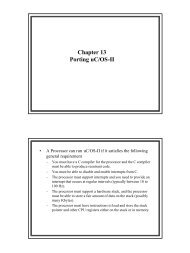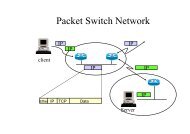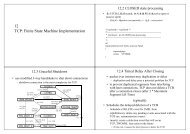IPv6 Addressing
IPv6 Addressing
IPv6 Addressing
You also want an ePaper? Increase the reach of your titles
YUMPU automatically turns print PDFs into web optimized ePapers that Google loves.
<strong>IPv6</strong> <strong>Addressing</strong>Understanding <strong>IPv6</strong> Slide: 1Lesson Objectives• <strong>IPv6</strong> address space and scope• <strong>IPv6</strong> address syntax• Unicast <strong>IPv6</strong> addresses• Multicast <strong>IPv6</strong> addresses• Anycast <strong>IPv6</strong> addresses• <strong>IPv6</strong> interface identifiers• IPv4 addresses and <strong>IPv6</strong> equivalentsUnderstanding <strong>IPv6</strong> Slide: 2
The <strong>IPv6</strong> Address Space• 128-bit address space• 2 128 possible addresses• 340,282,366,920,938,463,463,374,607,431,768,211,456 addresses (3.4 x 10 38 )• 6.65*1023 address for every square meter• 128 bits were chosen to allow multiplelevels of hierarchy and flexibility indesigning hierarchical addressing androuting• Typical unicast <strong>IPv6</strong> address:• 64 bits for subnet ID, 64 bits for interface IDUnderstanding <strong>IPv6</strong> Slide: 3• Address scope• Link local• Site local• Global• Address have lifetime• Basic Address Types• Unicast• Address of a single interface• For one-to-one comm.• Multicast• Address of a set of interfaces• For one-to-many comm.• Anycast• Address of a set of interfaces• For one-to-nearest comm.• Nearest is defined as being closest interm of routing distanceGlobalLink LocalSite LocalUMMAAM•No more broadcast addressesA
Current AllocationFormatFraction ofAllocation Prefix address spaceReserved 0000 0000 1/256NSAP Allocation 0000 001 1/128Aggregatable Global Unicast 001 1/8Link-Local Unicast 1111 1110 10 1/1024Site-Local Unicast 1111 1110 11 1/1024Multicast 1111 1111 1/256Understanding <strong>IPv6</strong> Slide: 5<strong>IPv6</strong> Address Syntax• <strong>IPv6</strong> address in binary form:00100001110110100000000011010011000000000000000000101111001110110000001010101010000000001111111111111110001010001001110001011010• Divided along 16-bit boundaries:0010000111011010 0000000011010011 0000000000000000 00101111001110110000001010101010 0000000011111111 1111111000101000 1001110001011010• Each 16-bit block is converted tohexadecimal and delimited with colons:21DA:00D3:0000:2F3B:02AA:00FF:FE28:9C5A• Suppress leading zeros within each 16-bit block:21DA:D3:0:2F3B:2AA:FF:FE28:9C5AUnderstanding <strong>IPv6</strong> Slide: 6
Compressing Zeros• Some <strong>IPv6</strong> addresses contain longsequences of zeros• A single contiguous sequence of 16-bitblocks set to 0 can be compressed to “::”(double-colon)• Example:• FE80:0:0:0:2AA:FF:FE9A:4CA2 becomesFE80::2AA:FF:FE9A:4CA2• FF02:0:0:0:0:0:0:2 becomes FF02::2• Cannot use zero compression to includepart of a 16-bit block• FF02:30:0:0:0:0:0:5 does not become FF02:3::5.Understanding <strong>IPv6</strong> Slide: 7<strong>IPv6</strong> Prefixes• Prefix is the part of the address wherethe bits have fixed values or are thebits of a route or subnet identifier• <strong>IPv6</strong> subnets or routes always usesaddress/prefix-length notation• CIDR notation• Examples:• 21DA:D3::/48 for a route• 21DA:D3:0:2F3B::/64 for a subnet• No more dotted decimal subnet masksUnderstanding <strong>IPv6</strong> Slide: 8
Address type PrefixesAddress typeIPv4-compatibleGlobal unicastLink-local unicastSite-local unicastmultcastBinary prefix00000… 0 (96 zero bits)0011111 1110 101111 1110 111111 1111According to the Prefix value, we can chose different routing tableUnderstanding <strong>IPv6</strong> Slide: 9Unicast <strong>IPv6</strong> Addresses• Aggregatable global unicast addresses• Link-local addresses• Site-local addresses• Special addresses• Compatibility addresses• NSAP addressesUnderstanding <strong>IPv6</strong> Slide: 10
Aggregatable Global Unicast Addresses• Top-Level Aggregation ID (TLA ID)• Next-Level Aggregation ID (NLA ID)• Site-Level Aggregation ID (SLA ID)• Interface ID13 bits 8 bits 24 bits16 bits64 bits001 TLA ID Res NLA IDSLA IDInterface IDUnderstanding <strong>IPv6</strong> Slide: 11Topologies Within Global Addresses• Public Topology /48bit• Site Topology /64bit• Interface ID 64/bit001 TLA ID Res NLA IDSLA IDInterface ID48 bits16 bits64 bitsPublic Topology Site Topology Interface IdentifierUnderstanding <strong>IPv6</strong> Slide: 12
Local-Use Unicast Addresses• Link-local addresses• Used between on-link neighbors and forNeighbor Discovery• Site-local addresses• Used between nodes in the same siteUnderstanding <strong>IPv6</strong> Slide: 13• Used for local link onlyLink-Local Addresses• Meaningful only in a single link zone, and may be reusedon other links• Link-local addresses for use during auto-configurationand when no routers are present• Required for Neighbor Discovery process, alwaysautomatically configuration• An <strong>IPv6</strong> router never forwards link local trafficbeyond the link• Format Prefix 1111 1110 10• FE80::/64 prefix10 bits 54 bits64 bits1111 1110 10 000 . . . 000Interface IDUnderstanding <strong>IPv6</strong> Slide: 14
Site-Local Addresses• Used for local site only• Equivalent to the IPv4 private addresses• Address are not automatically configured andmust be assigned• Routers do not forward site-local traffic outsidethe site• Format Prefix 1111 1110 11• FEC0::/48 prefix for site10 bits 38 bits 16 bits64 bits1111 1110 11 000 . . . 000 Subnet ID Interface IDUnderstanding <strong>IPv6</strong> Slide: 15Special <strong>IPv6</strong> Addresses• Unspecified address• 0:0:0:0:0:0:0:0 or ::• Equivalent to IPv4 0.0.0.0• Loopback address• 0:0:0:0:0:0:0:1 or ::1• Equivalent to IPv4 127.0.0.1Understanding <strong>IPv6</strong> Slide: 16
Compatibility Addresses• IPv4-compatible address• 0:0:0:0:0:0:w.x.y.z or ::w.x.y.z• Used by dual-stack nodes• IPv4-mapped address• 0:0:0:0:0:FFFF:w.x.y.z or ::FFFF:w.x.y.z• Represent an IPv4-only node to an <strong>IPv6</strong> node• 6over4 address• Interface ID of ::WWXX:YYZZ• 6to4 address• Prefix of 2002:WWXX:YYZZ::/48• ISATAP address• Interface ID of ::0:5EFE:w.x.y.zUnderstanding <strong>IPv6</strong> Slide: 17Multicast <strong>IPv6</strong> Addresses• Multicast address can not be used as source or asintermediate destination in a routing header• Flags• Transient or permanent multicast address• Scope• 1: node-local 2: link local 5: site-local 8:organization-local E:global• Defined multicast addresses• All-Nodes addresses• FF01::1 (Node Local), FF02::1 (Link Local)• All-Routers addresses• FF01::2 (Node Local), FF02::2 (Link Local), FF05::2 (Site Local)8 bits 4 bits 4 bits112 bits1111 1111 Flags ScopeGroup IDUnderstanding <strong>IPv6</strong> Slide: 18
Recommended Multicast <strong>IPv6</strong> Addresses• Only 32 bits are used to indicate theGroup ID• Single <strong>IPv6</strong> multicast address maps to a singleEthernet multicast MAC address8 bits 4 bits 4 bits 80 bits32 bits1111 1111 Flags Scope 000 … 000Group IDUnderstanding <strong>IPv6</strong> Slide: 19Solicited-Node Address (a multicast address)64 bits64 bitsUnicast prefixInterface ID24 bitsFF02:0:0:0:0:1:FF• For link-layer address resolution• Example:• For FE80::2AA:FF:FE28:9C5A, the correspondingsolicited-node address is FF02::1:FF28:9C5AUnderstanding <strong>IPv6</strong> Slide: 20
Anycast <strong>IPv6</strong> Addresses• Assigned to multiple interface• Only used as destination address• Only assigned to routern bits128 - n bitsSubnet Prefix 000 . . . 000Understanding <strong>IPv6</strong> Slide: 21<strong>IPv6</strong> Addresses for a Host• Unicast addresses:• A link-local address for each interface• Unicast addresses for each interface (site-localor global addresses)• A loopback address (::1)• Multicast addresses:• The node-local scope all-nodes multicastaddress (FF01::1)• The link-local scope all-nodes multicast address(FF02::1)• The solicited-node address for each unicastaddress• The multicast addresses of joined groupsUnderstanding <strong>IPv6</strong> Slide: 22
<strong>IPv6</strong> Addresses for a Router• Unicast addresses:• A link-local address for each interface• Unicast addresses for each interface• Loopback address (::1)• Anycast addresses• Subnet-router anycast address• Additional anycast addresses (optional)• Multicast addresses:• The node-local scope all-nodes multicast address (FF01::1)• The node-local scope all-routers multicast address (FF01::2)• The link-local scope all-nodes multicast address (FF02::1)• The link-local scope all-routers multicast address (FF02::2)• The site-local scope all-routers multicast address (FF05::2)• The solicited-node address for each unicast address• The multicast addresses of joined groupsUnderstanding <strong>IPv6</strong> Slide: 23<strong>IPv6</strong> Interface Identifiers• The last 64 bits of unicast <strong>IPv6</strong>addresses• Interface identifier based on:• Extended Unique Identifier (EUI)-64 address• Either assigned to a network adapter card or derived fromIEEE 802 addresses• Temporarily assigned, randomly generatedvalue that changes over time• A value assigned by a stateful addressconfiguration protocol (DHCP)• A value assigned during a Point-to-PointProtocol connection establishment• A manually configured valueUnderstanding <strong>IPv6</strong> Slide: 24
• Company ID• Extension ID• U/L bit (u)IEEE 802 Addresses• Universally (=0)/Locally (=1) Administered• U/G bit (g)• Unicast (=0)/Group (=1) Address24 bits 24 bitsccccccug cccccccc ccccccccxxxxxxxx xxxxxxxx xxxxxxxxIEEE-administered company IDManufacturer-selected extension IDUnderstanding <strong>IPv6</strong> Slide: 25IEEE EUI-64 Addresses• Extended Unique Identifier• Company ID• Extension ID24 bits 40 bitsccccccug cccccccc ccccccccxxxxxxxx xxxxxxxx xxxxxxxx xxxxxxxx xxxxxxxxIEEE-administered company IDManufacturer-selected extension IDUnderstanding <strong>IPv6</strong> Slide: 26
Conversion of an IEEE 802 Address to an EUI-64 AddressIEEE-administered company IDManufacturer-selected extension ID24 bits 24 bitsccccccug cccccccc ccccccccxxxxxxxx xxxxxxxx xxxxxxxxIEEE 802 Addressccccccug cccccccc cccccccc11111111 11111110xxxxxxxx xxxxxxxx xxxxxxxxEUI-64 Address0xFF0xFEUnderstanding <strong>IPv6</strong> Slide: 27Conversion of an EUI-64 Address to an <strong>IPv6</strong> Interface IDEUI-64 Addressccccccug cccccccc ccccccccxxxxxxxx xxxxxxxx xxxxxxxx xxxxxxxx xxxxxxxxComplement theuniversally/locallyadministered (U/L) bitccccccUg cccccccc ccccccccxxxxxxxx xxxxxxxx xxxxxxxx xxxxxxxx xxxxxxxx<strong>IPv6</strong> Interface IdentifierUnderstanding <strong>IPv6</strong> Slide: 28
Conversion of an IEEE 802 Address to an <strong>IPv6</strong> Interface IDIEEE-administered company ID Manufacturer-selected extension ID24 bits 24 bitscccccc00 cccccccc ccccccccxxxxxxxx xxxxxxxx xxxxxxxxIEEE 802 AddressEUI-64 Addresscccccc00 cccccccc cccccccc11111111 11111110xxxxxxxx xxxxxxxx xxxxxxxx0xFF0xFEcccccc10 cccccccc cccccccc11111111 11111110 xxxxxxxx xxxxxxxx xxxxxxxx<strong>IPv6</strong> Interface Identifier64 bitsUnderstanding <strong>IPv6</strong> Slide: 29IEEE 802 Address Conversion Example• Host A has the MAC address of 00-AA-00-3F-2A-1C• 1. Convert to EUI-64 format• 00-AA-00-FF-FE-3F-2A-1C• 2. Complement the U/L bit• The first byte in binary form is 00000000. When the seventh bit iscomplemented, it becomes 00000010 (0x02).• Result is 02-AA-00-FF-FE-3F-2A-1C• 3. Convert to colon hexadecimal notation• 2AA:FF:FE3F:2A1C• Link-local address for node with the MAC addressof 00-AA-00-3F-2A-1C is FE80::2AA:FF:FE3F:2A1C.Understanding <strong>IPv6</strong> Slide: 30
Mapping <strong>IPv6</strong> Multicast Addresses to Ethernet Addresses<strong>IPv6</strong>Multicast AddressFF...:8 16 24 32EthernetMulticast Address33-33-Understanding <strong>IPv6</strong> Slide: 31IPv4 Addresses and <strong>IPv6</strong> EquivalentsIPv4 Address<strong>IPv6</strong> AddressInternet address classes N/AMulticast addresses (224.0.0.0/4) <strong>IPv6</strong> multicast addresses (FF00::/8)Broadcast addressesN/AUnspecified address is 0.0.0.0 Unspecified address is ::Loopback address is 127.0.0.1 Loopback address is ::1Public IP addressesAggregatable global unicast addressesPrivate IP addressesSite-local addresses (FEC0::/48)APIPA addressesLink-local addresses (FE80::/64)Dotted decimal notation Colon hexadecimal formatSubnet mask or prefix length Prefix length notation onlyAPIPA: automatic private IP addressingUnderstanding <strong>IPv6</strong> Slide: 32


